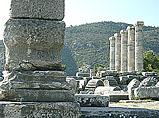|
Priene has by far the most spectacular site of any of the ancient Ionian cities , standing
on a narrow shelf of hillside high above the Meander Valley , with the mighty St.Mycale presiding majestically
above the ruins. It is hard to believe now, that Priene was once an active port on the coast
|

|
|
|
Temple of Athena Polias 
|
|
The ancient harbor city of Priene probably changed its location when the silt of the Meander River threatened to
bury it. Now it is nearly 16 km / 10 miles from the sea. The original place of the city has never been found but
it was probably a peninsula with two harbors. Priene was laid out on a Hippodamian system of grid plan at the foot
of a spectacular cliff on Mount Mycale and contained many famous examples of Hellenistic art and architecture.
All the streets intersect at right angles. Remaining small with about 4 or 5 thousand inhabitants and never of
great political significance it shared the same history as the other Ionian cities.

History of Priene
It was founded on the Ionian coast by the inhabitants of an abandoned Ionian city of the same name in c.350 BC.
It participated in the Battle of Lade with 12 ships in 494 BC. Alexander the Great assigned the city to watch the
unreliable city of Miletus. He also lived in the city and paid for the construction of the Athena Temple. After
flourishing during the Hellenistic and passing through the Pergamene Kingdom periods the city declined under Roman
rule and was later abandoned. Excavation began at the site in the early years of the 20C and the city has been
partially restored.

The Site
The city is organized in four districts, the religious (Athena Temple), the political (bouleterion and prytaneion),
the cultural (Theater) and the commercial (agora). In addition to the Athena Temple, the people of Priene built
shrines dedicated to Zeus, Demeter and Egyptian gods.
The Theater is a 4 or 3C BC building and one of the finest
extant theaters of the Hellenistic world. Although it was rebuilt in the Roman period it still
remains as typically Hellenistic as the city of Priene itself. The theater was carved into the hillside and held
a capacity of 5,000 people. Five marble seats with arms were provided for priests and dignitaries. In the middle
of the prohedria there was an altar which was sacred to Dionysus. Performances used to start with sacrificial rites.
The proskene is well-preserved and consists of a colonnade supported with 12 Doric half-columns. The skene had
an upper floor which no longer stands.

The Bouleterion is the most intact in Anatolia today. It was used for meetings of the town council. The
bouleterion consisted of seats on three sides with a capacity of 640 people, and was covered with a wide wooden
roof. The sacrificial altar was placed in the middle of the arc of seats.

The Prytaneion is located to the east of the bouleterion. It was the seat of the elected city administration
and housed official receptions. Rooms were set around the courtyard. The shrine of Hestia was in an inner chamber
where the eternal sacred flame was burned.

The Temple of Athena Polias was rebuilt in 334 BC as a gift from Alexander the Great and was a standard
Ionic structure with eleven columns along its sides, six at the ends and two in antis. Athena Polias was the goddess
of Priene and protectress of the city. The proportions of this temple were taken as a classical model or pattern
by the Roman architect Vitruvius. The architect of the Athena Temple was Pytheos who also built the Mausoleum at
Halicarnassus, one of the Seven Wonders of the ancient world.
Halikarnassos was part of the kingdom of Pergamon.
|

|
|

|
|
all boats - all itineraries,
choose a gulet  from here
from here

|
|